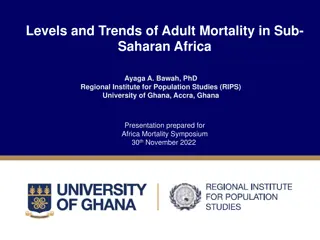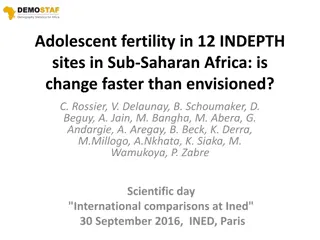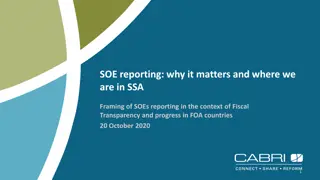Understanding Sub-Saharan Africa's Mortality Trajectory: Past, Present, and Future Prospects
Explore the mortality trends in Sub-Saharan Africa, focusing on infant and child mortality as well as adult mortality. Despite significant progress, challenges persist due to uneven gains globally. Child mortality has seen a substantial decline, but rates remain high. Public health interventions have played a crucial role in reducing child deaths, yet millions of children still succumb to mortality. Gain insights into the global context of mortality trends and the variations across different regions.
Download Presentation

Please find below an Image/Link to download the presentation.
The content on the website is provided AS IS for your information and personal use only. It may not be sold, licensed, or shared on other websites without obtaining consent from the author. Download presentation by click this link. If you encounter any issues during the download, it is possible that the publisher has removed the file from their server.
E N D
Presentation Transcript
Where is Sub-Saharan Africa in its Mortality Trajectory? Understanding the Past and Prospects for the Future Ayaga A. Bawah, PhD Regional Institute for Population Studies (RIPS) University of Ghana, Accra, Ghana Keynote Address Africa Mortality Symposium 29th November 2022
Outline Global Context Mortality Trends in Sub-Saharan Africa Infant and Child Mortality Adult Mortality Why Mortality Remains High in SSA Assessing Progress and Prospects for the Future
Global Context Globally there has been remarkable decline in mortality General mortality declined in excess of 67 percent Declines witnessed in all subregions of the world Due improvements in public health and socioeconomic conditions across the world But these gains have been uneven across the world
Variations in Levels and Trends in Under- five Mortality, by SDG Region, 1990-2019 200 180 180 160 140 124 120 Rate 100 80 76 60 57 55 40 38 35 20 20 14 16 5 14 0 1990 1995 2000 2005 Year 2010 2015 2019 Sub Saharan Africa Latin America and Caribbean Central & Southern Asia Oceania Eastern & South-East Asia Europe & North America
Childhood Mortality Witnessed Greatest Decline Gains have been particularly strong among children Since 1990 child mortality has declined by about 60 percent to about 58 deaths per 1000 in 2019 Most public health interventions have focused more on children and pregnant women
Despite Gains, Mortality Rates Remain Unacceptably High Despite reductions in global burden of child deaths, rates remain high For instance, 5.2 million deaths occurred among children under 5 years of age worldwide in 2019
Global Mortality Rates and Number of Deaths by Age, 2019 (UN Inter-agency Group for Child Mortality Estimation)
Most Child Deaths Concentrated in SSA Of the 5.2 million deaths to children under 5 years of age 53 percent occurred in SSA SSA also bears 44 percent of all child deaths 5-24 years of age
Under-five Mortality Rate (Deaths per 1,000 Live Births) by Country, 2019 (UN Inter-agency Group for Child Mortality Estimation)
Digging Deeper into SSA SSA has the highest risk of mortality both among children and adults But substantial progress has been made to reduce mortality in the region Data from the UN show that under 5 mortality in SSA declined from 180 in 1990 to 76 in 2019 Variations exist regionally
Trends in Childhood Mortality based on Gambia Health and Demographic Surveillance Data
Trends in Childhood Mortality from the Navrongo HDSS, Ghana
Mark Hereward, UNICEFs Associate Director on Data and Analytics We are still losing too many young lives from largely preventable causes, often because of weak and underfunded health systems which have faced enormous pressure over the pandemic. And the burden of these deaths is not carried equally around the world. Children in sub-Saharan Africa and Southern Asia continue to face the highest risk of death in the world, and to bear the brunt of this child mortality burden, If we are going to achieve the child mortality SDGs in all countries, we must redouble efforts to ensure access to effective and high-quality care along with the continued expansion of coverage of life-saving interventions. 20 December, 2021
Maternal and Adult Mortality Data on adult mortality has remained a challenge in the region Notwithstanding, the available data shows that progress has been made in reducing adult mortality WHO estimates that between 2000 and 2017 the maternal mortality ratio dropped by about 38.4% worldwide In SSA the MMR is estimated to have declined from 878 per 100,000 live births in 2000 to 542 per 100,000 live births in 2019
Trends in Maternal Mortality Rates in Africa (2000 2017) Source: Onambele et al . 2022. Int. J. Environ. Res. Public Health
Adult Mortality: Probability of Dying between 15 and 60 Years of Age 600 500 400 45q15 300 200 100 0 1950 1960 1970 1980 1990 Year 2000 2010 2020 2030
Trends in Life Expectancy in SSA Eastern and Southern Africa Western and Central Africa Middle East & North Africa Sub-Saharan Africa 80 70 60 Life Expectancy (Years) 50 40 30 20 10 0 1960 1962 1964 1966 1968 1970 1972 1974 1976 1978 1980 1982 1984 1986 1988 1990 1992 1994 1996 1998 2000 2002 2004 2006 2008 2010 2012 2014 2016 2018 2020 Year
Why Mortality Remains High in SSA Vaccine-preventable childhood deaths continue to be high High Maternal mortality Infectious diseases remain a major threat to many people in the region Large segments of the population remain poor and continue to die of either poverty-related diseases or unable to afford healthcare Noncommunicable diseases are on the rise in many countries of the region
Why Mortality Remains High in SSA Injury mortality is on the rise and if nothing drastic is done it will become a leading cause of death among adults Bawah et al. Injury Epidemiology 2014 Health systems are poor and inequitable in many countries
Assessing Progress and Prospects for the Future The major challenge affecting mortality research in Africa is lack of good quality data. For purposes of planning there is need to give priority to improving data generation, particularly at the district level. Data on causes of death must be given priority attention. In this regard countries can think of setting up sentinel sites Priority must be given to deal with the health system challenges confronting many countries in SSA
Assessing Progress and Prospects for the Future SDG target 3.1: By 2030, reduce the global maternal mortality ratio to less than 70 per 100000 live births Projections suggest that SSA is not likely to meet this target According to the latest estimates by UN IGME 50 countries are off mark towards achieving the SDG under mortality target and 60 for the neonatal mortality target. Equity in access to health care remains a major challenge and this must be prioritized if must achieve mortality reductions. If progress must be made, we must double efforts to address problems
Thank you for your attention Email: aabawah@ug.edu.gh

























